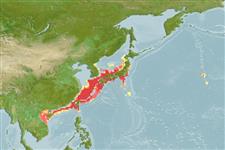>
Acropomatiformes (Oceanic basses) >
Acropomatidae (Lanternbellies, temperate ocean-basses)
Etymology: Acropoma: Greek, akro = topmost, summit + Greek, poma, -atos = cover (Ref. 45335).
Environment: milieu / climate zone / depth range / distribution range
Ökologie
seewasser benthopelagisch; tiefenbereich 50 - 400 m (Ref. 96184). Temperate
Northwest Pacific: southern Japan to Taiwan.
Size / Gewicht / Alter
Maturity: Lm ? range ? - ? cm
Max length : 13.5 cm SL Männchen/unbestimmt; (Ref. 96184)
Rückenflossenstacheln (insgesamt) : 9; Rückenflossenweichstrahlen (insgesamt) : 10; Afterflossenstacheln: 3; Afterflossenweichstrahlen: 7. Anus nearer the insertion of anal fin than that of pelvic fin. Two very long light organs run from the isthmus to slightly beyond the origin of the anal fin and joined with the opposite organ immediately in front of the anal fin.
Found in fairly deep water. Caught by trawl net. Food fish.
Life cycle and mating behavior
Maturities | Fortpflanzung | Spawnings | Egg(s) | Fecundities | Larven
Okamoto, M., 2014. Acropoma profundum, a new species of lanternbelly (Teleostei: Perciformes: Acropomatidae) from the Solomon Islands. Species Diversity 19:9-14. (Ref. 96184)
IUCN Rote Liste Status (Ref. 130435)
Bedrohung für Menschen
Harmless
Nutzung durch Menschen
Fischereien: kommerziell
Tools
Zusatzinformationen
Download XML
Internet Quellen
Estimates based on models
Preferred temperature (Ref.
123201): 9.7 - 20.9, mean 18.1 °C (based on 126 cells).
Phylogenetic diversity index (Ref.
82804): PD
50 = 0.5156 [Uniqueness, from 0.5 = low to 2.0 = high].
Bayesian length-weight: a=0.01148 (0.00470 - 0.02806), b=3.01 (2.80 - 3.22), in cm total length, based on LWR estimates for this (Sub)family-body shape (Ref.
93245).
Trophic level (Ref.
69278): 3.5 ±0.5 se; based on size and trophs of closest relatives
Widerstandsfähigkeit (Ref.
120179): hoch, Verdopplung der Population dauert weniger als 15 Monate. (Preliminary K or Fecundity.).
Fishing Vulnerability (Ref.
59153): Low vulnerability (10 of 100).
